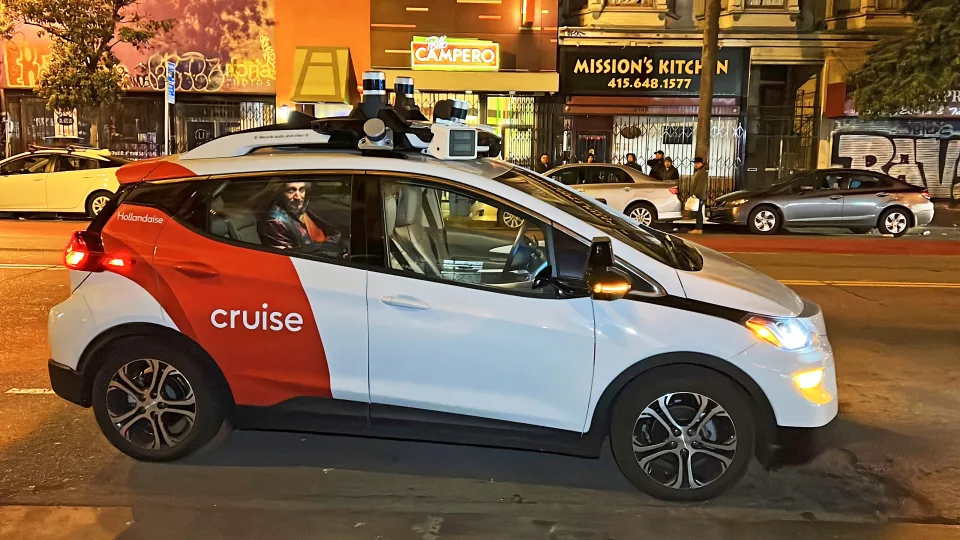The year began on a positive note for robotaxis, with Cruise and Waymo enjoying significant investments from General Motors and Google, respectively. There was a surge in public interest, and city governments were increasingly embracing self-driving technology. The self-driving vehicle industry seemed to be on an upward trajectory. However, the promising outlook took a sharp turn when a driverless Cruise taxi was involved in an incident where it unintentionally dragged a hit-and-run victim down a San Francisco street. This unfortunate event had a cascading effect, leading to a downturn in the fortunes of the autonomous taxi tech industry. The fragility of these “Next Big Things” became evident. As we reflect on the year, it’s worth exploring how autonomous taxi technology might recover from this significant setback.
Cruise’s compounding problems
Cruise entered the year as a formidable force driving transformative changes in transportation, positioned at the core of General Motors’ self-driving initiatives. In March 2022, GM invested $1.5 billion in Cruise, following a $2.1 billion equity ownership purchase from Softbank Vision Fund. In February of the same year, Cruise made headlines by announcing that its test fleet of driverless taxis had covered a million miles on the streets of San Francisco without any human intervention, a remarkable feat considering the program had only commenced in November of the previous year.
Mo Elshenawy, Cruise’s EVP of engineering, emphasized the significance of their safety record in February, stating, “When you consider our safety record, the gravity of our team’s achievement comes into sharper focus. To date, riders have taken tens of thousands of rides in Cruise AVs. In the coming years, millions of people will experience this fully driverless future for themselves.” The positive trajectory and achievements during this period underscored Cruise’s position as a leader in the autonomous vehicle space.
Cruise CEO Kyle Vogt assumed his position in December 2021, succeeding Dan Ammann after GM CEO Mary Barra’s decision to make a leadership change. Over the following year, Vogt articulated an ambitious vision of achieving “zero crashes, zero traffic, and zero emissions.” However, a November report from the New York Times suggested that under Vogt’s leadership, Cruise prioritized the speed of its program over safety, allegedly cutting corners to expedite the deployment of more vehicles on the road. Despite this, Cruise expanded its operations into Houston and Los Angeles, even as the number of traffic incidents and accidents involving its vehicles increased.
In April, Cruise received permission to operate its driverless vehicles throughout San Francisco 24/7 and to pick up paying passengers during daylight hours. Prior to this, only Cruise employees were allowed to ride in the robotaxis, and operations were restricted to daylight hours. In August, the California Public Utilities Commission (CPUC) voted 3-to-1 in favor of allowing Cruise, as well as Waymo, to pick up paying passengers at all hours. These developments marked significant milestones in Cruise’s efforts to integrate autonomous vehicles into public transportation.
The robotaxi takeover faced resistance from some quarters. In January 2023, San Francisco officials urged the California Public Utilities Commission (CPUC) to slow down or halt the expansion of self-driving vehicle services in the city. They argued that the rapid and unrestricted growth approved by state regulators was becoming an “unreasonable” burden. Just a week after the CPUC voted in favor of expansion, the California Department of Motor Vehicles (DMV) initiated an investigation into an incident involving a Cruise taxi and a fire truck. In response, the DMV required Cruise to reduce its operating fleet by half—down to 50 vehicles during daylight hours and 150 at night—until the investigation was completed.
Furthermore, there was a notable incident in August involving the inappropriate use of robotaxis as “love hotels,” adding to the challenges and concerns surrounding the deployment of autonomous vehicles in urban environments. These incidents underscored the complexities and controversies surrounding the integration of self-driving technology into public transportation systems.
(1/3) At approximately 9:30 pm on October 2, a human-driven vehicle struck a pedestrian while traveling in the lane immediately to the left of a Cruise AV. The initial impact was severe and launched the pedestrian directly in front of the AV.
— cruise (@Cruise) October 3, 2023
The incidents, especially those of October 3, were deeply troubling, and Cruise’s response to the ensuing investigation was deemed unacceptable. According to the company’s initial explanation, a human-driven vehicle struck a pedestrian, causing her to be pushed into the path of a Cruise taxi in the adjacent lane. Despite aggressive braking attempts, the taxi ran over the woman, ultimately dragging her for a distance of 20 feet before coming to a stop. Emergency medical services (EMS) crews used the jaws of life to extract the pedestrian from underneath the taxi and swiftly transported her for critical medical treatment. While the pedestrian has not been identified, reports as late as October 25 indicated that she remained in serious condition. The severity of the incident raised significant concerns about the safety and reliability of autonomous vehicles in real-world scenarios.
Cruise’s troubles compounded as the company allegedly misled regulators about the timeline of the incident, particularly regarding when the taxi engaged its brakes. Initial reports suggested that Cruise informed regulators that the taxi had immediately come to a stop, not gradually, after traveling an additional 20 feet down the block. Moreover, the company reportedly delayed the release of video footage of the incident to investigators until October 19.
These actions have put Cruise at financial risk with the California Public Utilities Commission (CPUC), which is contemplating fines of up to $1.5 million for the company’s alleged attempts to obscure the truth. The CPUC is expected to make a decision on this matter in early February during an upcoming evidentiary hearing.
In the wake of the accident, various investigations, both regulatory and internal, were initiated. Exponent, an independent consulting firm, was enlisted as an investigator and uncovered data revealing challenges with Cruise’s robotaxis detecting and reacting to the presence of small children. While concerning, this revelation paled in comparison to the company’s decision to keep the vehicles on the road even after being informed of the potentially life-threatening defect. These developments underscored serious issues with safety protocols and transparency in Cruise’s autonomous vehicle operations.
The aftermath of the accident triggered a series of investigations, both regulatory and internal. The Exponent consulting firm, appointed as an independent investigator, uncovered troubling data regarding Cruise’s robotaxis’ challenges in detecting and responding to the presence of small children. This revelation was overshadowed by the company’s decision to continue operating the vehicles even after being made aware of the potentially life-threatening defect.
The California Department of Motor Vehicles (DMV) responded by suspending Cruise’s license to operate in the state, effectively shutting down its robotaxi operations. This was a significant setback for GM, which had invested billions in Cruise and anticipated the robotaxi service to generate up to $5 billion annually when operations were set to commence in 2025. In mid-November, Cruise recalled all 950 of its autonomous taxis in operation and temporarily halted robotaxi rides with human safety drivers a week later, initiating a comprehensive safety review.
The situation worsened with the resignation of CEO Kyle Vogt on November 18, a week after GM appointed Craig Glidde as Chief Administrative Officer. Following Vogt’s departure, co-founder and Chief Product Officer Daniel Kan also announced his exit. In response, GM elevated Mo Elshenawy from EVP of Engineering to the dual role of President and CTO, leaving the CEO position vacant. GM CEO Mary Barra expressed confidence in the co-presidents but emphasized a commitment to meeting strict safety requirements. The upheaval in leadership and operational disruptions highlighted the significant challenges faced by Cruise in maintaining its autonomous vehicle program.
Facing the financial fallout and loss of public trust, GM swiftly cut off funding to Cruise, resulting in budget reductions amounting to “hundreds of millions” of dollars. In response, Cruise suspended its equity program and initiated layoffs, starting with employees in autonomous vehicle operations.
In a statement, Cruise acknowledged the need to rebuild public trust and emphasized the importance of introspection and reforming internal processes, even if it involves uncomfortable or difficult decisions.
While Cruise faces significant challenges, the company is not entirely defunct. Mo Elshenawy, now serving as President and CTO, outlined in a recent email to staff that Cruise plans to scale back its self-driving ambitions and refocus on the current Chevy Bolt AV robotaxi platform rather than its custom-built Origin vehicle. Consequently, the production of the Origin will be put on hold at least through 2024, but the company intends to resume the program at a later date. The strategic shift reflects Cruise’s efforts to navigate its current difficulties and chart a more sustainable path forward.
Waymo won by default
Waymo began 2023 on a positive note, sharing the optimism and promise surrounding self-driving vehicle technology. The Google-backed company had earned praise from Swiss RE, a prominent global reinsurer, for the safety of its vehicles compared to human drivers in the previous September. Additionally, in December, Waymo expanded its Waymo One taxi service to a new area, this time in Phoenix, Arizona, introducing a route between downtown and the Phoenix Sky Harbor International Airport. These developments reflected Waymo’s commitment to advancing autonomous transportation and expanding its services to different locations.
Following a rigorous cycle of validation and safety readiness evaluation, @Waymo is starting fully-autonomous (no human driver) testing in LA. Thrilled by the data confirming, once again, how well our ML-based 5th-gen Driver generalizes across cities! pic.twitter.com/hd0XU5zecT
— Dmitri Dolgov (@dmitri_dolgov) February 27, 2023
Waymo expanded its presence to Los Angeles in February, bringing its self-driving vehicles to the city. Similar to the rollout in San Francisco, Waymo initially restricted access to its self-driving rides for participants in the Waymo Research Trusted Tester program in a limited area, specifically Santa Monica. The service was available outside of rush hours and with a cap on the number of vehicles.
In March, Waymo launched a similar initiative in Austin, Texas, where the company had conducted some of its earliest self-driving tests in 2015. The regulatory landscape in Austin, influenced by a 2017 state law, made it an attractive location for testing self-driving technology, as cities were prevented from locally regulating its use and deployment.
By summer, Waymo’s progress was evident, prompting the company to adjust its focus. In July, Waymo announced a strategic shift, delaying its plans for self-driving trucks to concentrate entirely on expanding its robotaxi service. The co-CEOs, Tekedra Mawakana and Dmitri Dolgov, emphasized the significant business growth and rider demand in San Francisco, Phoenix, and Los Angeles, citing these factors as drivers for the decision to prioritize the ride-hailing aspect of their autonomous technology.
In August, Waymo expanded its autonomous taxi service to Austin, making it the fourth city to host the program, with the rollout planned for the fall. During the same month, Waymo received its driverless deployment permit from the California Public Utilities Commission (CPUC). This permit allowed Waymo to charge passengers for its robotaxi rides and expand the service to additional customers without the need for a human safety driver. The company acknowledged the high demand for its services, with signups reportedly surpassing 100,000 users. While demand was “incredibly high,” Waymo expressed its commitment to making fully autonomous trips available to everyone over time.
Despite these positive developments, Waymo faced internal challenges with its workforce. The company underwent three rounds of layoffs, affecting over 300 employees. This was a notable contrast to the overall success and growth of Waymo’s autonomous taxi service in multiple cities, especially considering the challenges faced by its chief rival, Cruise, during the same period.
The Road Ahead for Robotaxis
As we enter the new year, Waymo stands out as a significant player in the autonomous vehicle landscape, especially with Cruise facing challenges and uncertainties in its commercial viability for the foreseeable future.
Analysts predicted substantial growth in the robotaxi market, which was valued at just over $1.1 billion in 2022. Estimates projected the market to reach anywhere from $45.7 billion in 2030 to $118 billion in 2031. Factors contributing to this growth included increasing demand for shared transportation, advancements in vehicle technology, a growing interest in fuel-efficient public transportation, and improved infrastructure.
However, recent developments, especially with Cruise temporarily out of the market, have tempered short-term estimates. Forrester Analytics, for instance, now anticipates that drone delivery services will become the dominant self-driving vehicle segment in 2024. Regulatory pushback slowing the development of robotaxi transit technology has contributed to this shift.
As the industry evolves, expectations remain high, and the emergence of self-driving technologies in various applications, such as forklifts, curbside delivery robots, and drone delivery, is anticipated. The increasing popularity of e-commerce, the demand for last-mile delivery solutions, and advancements in autonomous technologies are driving this evolution. Amidst these developments, Elon Musk’s promise of a million robotaxis, made back in 2019, remains a point of anticipation in the industry.




